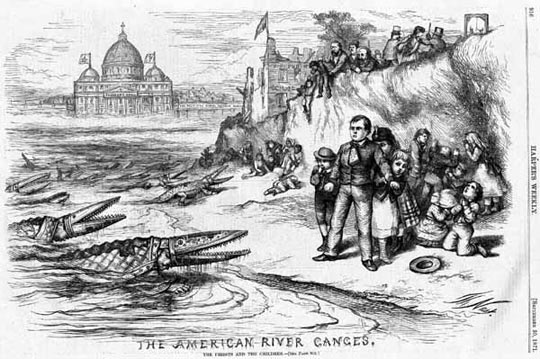Opening the Course

Oh, say can you see
By the dawn’s early light
What so proudly we hailed
At the twilight’s last gleaming
is rendered as
Amanece: ¿lo véis a la luz de la aurora
Lo que tanto aclamamos la noche al caer?
Sus estrellas, sus franjas flotaban ayer,
En el fiero combate en señal de victoria.1
The History of American Identity
3The American debate triggered by the Spanish version of the national anthem points to a problem which, half a century ago, the famous psychologist Erik H. Erikson, who fled from Nazi Germany to the U.S., defined by observing that America “attempts to make a super-identity out of all the identities imported by its constituent immigrants.”4 This observation is still valid today, when someone’s identity as a member of a particular nation is more difficult to define than ever before. Having suffered the consequences of rampant nationalism and living in a period of globalization in which migration waves, supranational institutions, and transnational economies make old national borders blur, whereas ethnic and religious wars create ever new barriers, we cannot be surprised that the notion of ‘national identity’ has become a contested concept. 4The German controversy about a questionable deutsche Leitkultur versus Habermas’ Verfassungspatriotismus on the one hand and the strife about the degree of linguistic competence and cultural knowledge which immigrants can be expected to acquire on the other shows our uneasiness about what it means to be ‘German,’ and when the well-known Islam-expert Bassam Tibi recently observed: “Das Problem ist: Deutschland kann den Fremden keine Identität anbieten, weil die Deutschen selbst kaum eine haben. Das ist wohl eine Folge von Auschwitz. Die Stärke Amerikas ist, dass es in eine Gemeinschaft aufnehmen kann,”5 he made a point well worth discussing. But in the U.S., after the ‘culture wars’ of the nineties, the shock of 9/11, and the growing doubts about the war in Iraq, the definition of what it means to be ‘American’ has become equally controversial, and that is best documented by Samuel P. Huntington’s recent bestseller Who Are We? America’s Great Debate (2004).6 5Applied to individuals the concept of ‘identity’ is hard enough to define, but applied to nations it becomes even fuzzier. Basically, ‘identity’ is an individual’s or a group’s sense of self over time. Both individuals and groups have identities, but the former can only define their identities in the context of the latter. They can have multiple economic, cultural, political, national, and other identities, which are of different salience in given times and situations. All of these identities are constructed, and as products of the interaction between the self or group and others they require comparison and evaluation, which invariably leads to auto- and hetero-stereotypes that endanger transnational understanding. Since the concept of ‘nation’ originated only in the mid-eighteenth century as a result of wars fought by groups with different languages, religions, and histories in order to develop a collective identity in contrast to that of others, the notion of ‘national identity’ is a young one. Simplifying a very complex issue for teaching purposes, one might say that we usually distinguish two types of ‘nation.’ The good type is a society based on a social contract, is open to all who want to join, and is patriotic. The bad type is a society based on ethnic characteristics or ideological tenets, is limited to those who share these traits or beliefs, and is nationalistic. 6As far as the U.S. is concerned, the origins of its national identity could only be abstract and ideological, since in contrast to Germany, which had something like a linguistic and cultural identity before it belatedly became a political unity in 1871, the American Revolution created a new political entity with a need for a national consciousness, which could neither be derived from the diverse languages, religions, and nationalities of the settlers in the thirteen colonies nor defined in contrast to the political opponents but cultural ancestors in Britain. Thus, Philip Gleason rightly states that “the United States defined itself as a nation by commitment to the principles of liberty, equality, and government on the basis of consent, and the nationality of its people derived from their identification with those principles.”7 Around 1790, eight out of ten white Americans were of British derivation, and therefore there was also a certain disposition towards defining nationhood in terms of descent, which is shown by the fact that blacks and Native Americans were excluded for reasons of race. But the essential condition for becoming an American was not an immigrant’s national, ethnic, linguistic or religious background, but his commitment to the universal ideas of equality and republicanism, his willingness to accept the English tradition of liberty, and his orientation towards a new and better future. This commitment made G. K. Chesterton observe that “America is the only nation in the world that is founded on a creed,”8 and in 1917 this creed became known as the ‘American Creed,’ formulated in William Tyler Page’s winning entry to a patriotic contest, as, in his own words, “the summary of the fundamental principles of the American political faith as set forth in its greatest documents, its worthiest traditions, and its greatest leaders,”9 and adopted by Congress in the following year. Such an ideologically motivated identity concept made naturalization surprisingly easy, and during the period of mass immigration from the first federal law of 1790 to the Naturalization Law of 1906, free white immigrants, no matter what their nationality or language, could become American citizens by simply swearing that they had lived in the U.S. for five years, would renounce all hereditary titles and political allegiance to any other state, and would support the U.S. constitution. 7But in a country which had always defined itself as Protestant in stark opposition to Catholicism, this openness changed when, in the half-century before the Civil War, immigration led to a massive growth of the Catholic population. In 1790 there had been only 35,000 Catholics, but when by 1860 their number had grown to 3.1 million, religion began to play a major role in the definition of national identity. Anti-Catholicism led to the short-lived Know-Nothingism and to bitter fights about educational policy. New public schools were set up as ‘Americanizing’ institutions meant to counter the detrimental effects of the parochial schools founded by Irish immigrants. Thus, national identity was no longer a primarily ideological notion, but religion, education, and cultural customs and values became important ingredients. Thomas Nast’s famous cartoon about “The American River Ganges: The Priests and the Children” (1871) provides an ideal illustration of the widespread anti-Catholic feelings.Thomas Nast, “The American River Ganges,” Harper’s Weekly, 30 September 1871,
http://www.yale.edu/glc/archive/1106.htm.
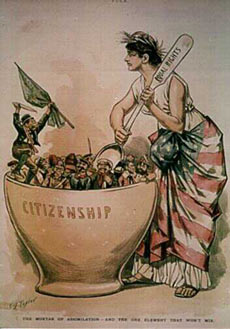
Puck Magazine, 26 June 1889,
http://museum.msu.edu/museum/
tes/immigration.htm.
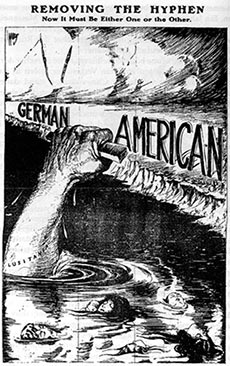
http://www.butterflystorm.com/
Work/GermanTexts/Removing%20
the%20Hyphen.htm.
- the question as to which and how many immigrants are to be admitted to the U.S. and how they are to be assimilated has been and still is of decisive importance for America’s national identity, and that
- in the course of its history, America’s national identity has always oscillated between the unum and the plures, the unifying power of a shared creed and the diversifying tendencies of many ethnicities.
At present, both the revival of ethnicity and the concurrent doubts as to the salience of the creed have led to what some diagnose as a crisis of nationality, and it is against this background that Huntington advances his controversial thesis. For him “the distinct Anglo-Protestant culture of the founding settlers” provided the unifying element for all later immigrant groups, who adopted the key elements of that culture, namely the English language; Christianity; religious commitment; English concepts of the rule of law, the responsibility of rulers, and the rights of individuals; and dissenting Protestant values of individualism, the work ethic, and the belief that humans have the ability and the duty to try to create a heaven on earth, a ‘city on a hill.’20
16Because this heritage has been lost, he sees the traditional American identity threatened by a growing number of disruptive forces, and argues that in reaction to these threats it might develop in four directions:- a creedal America, lacking its historic cultural core, and united only by a common commitment to the principles of the American Creed;
- a bifurcated America, with two languages, Spanish and English, and two cultures, Anglo-Protestant and Hispanic;
- an exclusivist America, once again defined by race and ethnicity and that excludes and/or subordinates those who are not white and European;
- a revitalized America reaffirming its historic Anglo-Protestant culture, religious commitments, and values and bolstered by confrontations with an unfriendly world;
- some combination of these and other possibilities.21
It would be interesting to speculate on which of these identities will result from the combined onslaught of a growing stream of Hispanic and Asian immigrants who bring other cultures and languages, the erosive impact of cosmopolitan intellectuals who reject the concept of ‘nation’ as obsolete, the leaders of global corporations who want to profit from the dismantling of national borders, and militant multiculturalists who jeer at the notion that an immigrant society should even try to achieve cultural unity. And it would be fascinating to join in the quarrel about whether Huntington is right when he argues that these developments endanger the coherence of the U.S. and jeopardize its future as a liberal democracy and that only a revival of a civic patriotism on a religious basis can stop the ongoing disintegration.22 Such speculations, however, are beyond the limits of the EFL-classroom.
Unit 1: A Historical Survey by Means of Central Texts
17In 1782, the French nobleman Michel-Guillaume Jean de Crèvecœur, who had been a prosperous farmer in Orange County, New York, but who, after independence, was forced to leave the country because of his pro-Tory sentiments, had his Letters from an American Farmer published by a London bookseller. The famous “Third Letter,” which contains one of the most often quoted passages in American writing, is the first attempt at addressing the new, and crucial, problem of American identity. When the theocratic Puritans of New England, the peaceful Quakers of Pennsylvania, the aristocratic British planters of Virginia, the Catholic settlers of Maryland, the Krefeld Mennonites in Germantown, and the many others who had come to the thirteen British colonies, looked around, they wondered what, despite their different languages, ethnic backgrounds, and religious beliefs, made them citizens of the newly founded United States and representatives of that newly created species, the ‘American.’ Crèvecœur argued:He is neither an European, nor the descendant of an European, hence that strange mixture of blood, which you will find in no other country. […] He is an American, who, leaving behind him all his ancient prejudices and manners, receives new ones from the new mode of life he has embraced, the new government he obeys, and the new rank he holds. He becomes an American by being received in the broad lap of our great Alma Mater. Here individuals of all nations are melted into a new race of men, whose labours and posterity will one day cause great changes in the world.
And answering his question “What, then, is the American, this new man?” he maintained that most immigrants wanted to forget the oppression, religious persecution, and poverty from which they had fled and that their attachment to their home country was limited to “the knowledge of the language” and “the love of a few kindred.” He argued that they speedily forgot their roots according to ubi panis ibi patria and turned into ‘Americans.’ In his view, Americans were created through a metamorphosis, a radical transformation effected by a new geographical and social environment, the shedding of “all [their] ancient prejudices and manners,” and the adoption of a new orientation resulting from a “new mode of life,” a “new government,” and a “new rank.” For him, immigrants became Americans “by being received in the broad lap of our great Alma Mater,” and it was upon American soil, personified as a nourishing Earth Mother, that “individuals of all nations are melted into a new race of men, whose labours and posterity will one day cause great changes in the world.”23
18This statement, which accentuated the newness and the future orientation of the ‘American’ identity as evolving through a process of assimilation, marked the beginning of an influential national myth. A century later it was taken up by the British Jew Israel Zangwill, who had David Quixano, the hero of his influential play The Melting Pot, rhapsodize: “America is God’s Crucible, the great Melting-Pot where all the races of Europe are melting and re-forming! – the real American has not yet arrived. He is only in the Crucible, I tell you – he will be the fusion of all races, perhaps the coming superman.24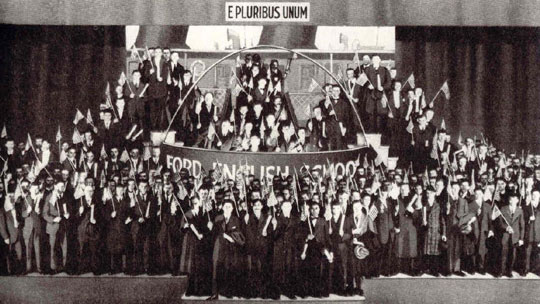
“The Ford English School Graduation Ceremony,” Peter Freese, ed. From Melting Pot to Multiculturalism: E pluribus unum? – Resource Book. (München: Langenscheidt, 2005), 88.
19This elevation of the French aristocrat’s theoretical notion of ‘melting’ into the British Jew’s concrete metaphor of the ‘melting pot’ was dramatically translated into reality by Henry Ford, the rabid anti-Semite, who had an almost pathological desire to ‘Americanize’ his workers. His Sociological Department investigated the home lives of his immigrant workers to check whether they had adopted the desired American habits such as washing regularly and brushing their teeth, and to decide whether they were worthy of receiving the five-dollar daily wage which Ford offered in 1914. Moreover, all immigrant workers had to attend compulsory English classes, and at the end of each class a spectacular graduation ceremony illustrated their transformation in the mythic American ‘melting pot.’ Here is what the Ford Times of 1916 had to say about it:The “Melting Pot” exercises were dramatic in the extreme: A deckhand came down the gang plank of the ocean liner, represented in canvas facsimile. “What cargo?” was the hail he received. “About 230 hunkies,” he called back. “Send’em along and we’ll see what the melting pot will do for them,” said the other and from the ship came a line of immigrants, in the poor garments of their native lands. Into the gaping pot they went. Then six instructors of the Ford school, with long ladles, started stirring. “Stir! Stir!” urged the superintendent of the school. The six bent to greater efforts. From the pot fluttered a flag, held high, then the first of the finished product of the pot appeared, waving his hat. The crowd cheered as he mounted the edge and came down the steps on the side. Many others followed him, gathering in two groups on each side of the cauldron. In contrast to the shabby rags they wore when they were unloaded from the ship, all wore neat suits. They were American in looks. And ask anyone of them what nationality he is, and the reply will come quickly, “American!” “Polish-American?” you might ask. “No, American,” would be the answer. For they are taught in the Ford school that the hyphen is a minus sign.25
20Recently, Jeffrey Eugenides has described this ceremony in his Pulitzer Prize-winning novel Middlesex (2002) in colorful detail.26 It is the very myth of the ‘melting pot’ which in 1959 the historian Arthur M. Schlesinger Sr. counted among America’s ten greatest contributions to civilization,27 but about which, in 1963, Nathan Glazer and Daniel Patrick Moynihan laconically observed in their study Beyond the Melting Pot: The Negroes, Puerto Ricans, Jews, Italians, and Irish of New York that “the point about the melting pot […] is that it did not happen.”28 21Crèvecœur’s Third Letter, excerpts from or – better – the whole of Zangwill’s play, and the photograph of and contemporary comment on the ceremony in Ford’s language classes together with Eugenides’ fictionalization constitute a small but highly useful teaching unit. Teachers who also want to represent the positions of 100% Americanization and Anglo-Saxon Racialism and to document the degree to which the notion of ‘race’ dominated the national identity discourse at a particular time, can add the following excerpt from Josiah Strong’s Our Country (1885), in which he predicted the eventual victory of the supreme Anglo-Saxon race in its newly evolving headquarters in the American West:The Anglo-Saxon is the representative of two great ideas, which are closely related. One of them is that of civil liberty, […] The other […] is that of a pure spiritual Christianity […] these are the forces which, in the past, have contributed most to the elevation of the human race, and they must continue to be, in the future, the most efficient ministers to its progress. It follows, then, that the Anglo-Saxon […] sustains peculiar relations to the world‘s future, is divinely commissioned to be, in a peculiar sense, his brother‘s keeper. […] Does it not look as if God were not only preparing in our Anglo-Saxon civilization the die with which to stamp the peoples of the earth, but as if he were also massing behind that die the mighty power with which to press it? [In the near future the world] will enter upon a new stage of its history – the final competition of races, for which the Anglo-Saxon is being schooled […].29
Or they can add a passage from Madison Grant’s The Passing of the Great Race (1916), in which he deplored the admission of immigrants of inferior racial stock and predicted America’s ethnic suicide:
God has not been preparing the English-speaking and Teutonic peoples for a thousand years for nothing but vain and idle self-contemplation and self-admiration. No! He has made us the master organizers of the world to establish system where chaos reigns. He has given us the spirit of progress to overwhelm the forces of reaction throughout the earth. He has made us adepts in government that we may administer government among savage and senile peoples. […] And of all our race he has marked the American people as His chosen Nation finally to lead in the regeneration of the world. This is the divine mission of America, and it holds for us all profit, glory, happiness possible to man. We are trustees of the world‘s progress, guardians of its righteous peace.”31
But even without these additions, the basic selection offers material for a discussion of almost all the crucial aspects of America’s identity and, moreover, provides the desirable transfer value concerning parallel problems in present-day Germany.
Unit 2: The Language Issue
23Over 130 ethnic groups make the U.S., ethnically speaking, one of the most heterogeneous countries in the world. Linguistically, however, the country is still surprisingly homogeneous. But there is a growing fear that this will change, and thus any EFL-course on the relation between ethnic diversity and national unity needs to deal with the language issue. 24It is true that the Founding Fathers did not establish English as the official language in the constitution,32 and it is also true that such non-participatory groups as the Old Order Amish, the Pennsylvania Dutch or the Lubavitcher Jews clung to their mother tongues and spoke both a private and a public language. But on the whole, the linguistic integration of immigrants was no problem, and that stock-in-trade ingredient of immigration literature, the night-school scene, shows that all newcomers strove to learn English as fast as possible. President Theodore Roosevelt’s laconic observation that every immigrant should be given a chance to learn English, but “if, after say five years, he has not learned English, he should be sent back to the land from whence he came,”33 illustrates the traditional position. 25According to the official guide for new immigrants, which would make an excellent authentic text for the EFL-classroom,34 among the prerequisites which newcomers must fulfill to be granted citizenship are still a sufficient command of English and a basic knowledge of civics. But since, in the context of the Civil Rights movement, Spanish-speaking immigrants from Central and South America insisted on bilingual schools, things have become ever more complicated. The 1968 Bilingual Education Act provided money for special programs for so-called LESA (= limited English-speaking ability) children,35 and in 1974 the Supreme Court ruled in Lau v Nichols that the San Francisco School District had to provide assistance to non-English-speaking Chinese. Thus began the nationwide introduction of bilingual education, which flourished in the multicultural climate of the eighties and nineties.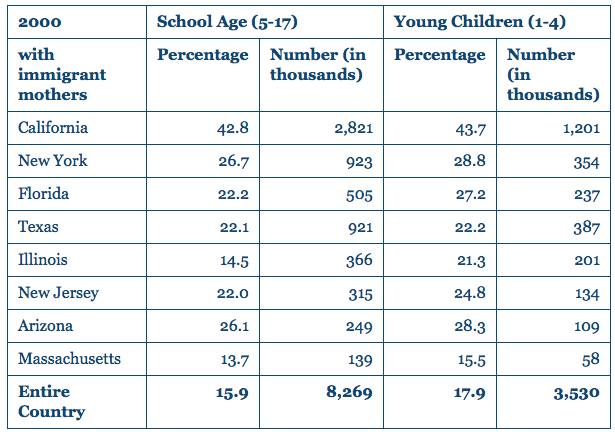
- maintained bilingual education with native-language instruction continued alongside English,
- transitional bilingual education with native-language instruction being gradually phased out,
- English-only education, sometimes with ‘structured immersion’ programs in which the level of English is geared to the students’ comprehension (US-English37), and
- bilingual education instructing English-speaking and non-English-speaking children in both languages (English Plus38).
Organizations like the influential ‘U.S. English’ fear a linguistic Balkanization and demand that official government business must be conducted solely in English at all levels. That means that all public documents, records, legislation and regulations as well as hearings, official ceremonies, and public meetings have to be in English and that exceptions are only permitted for public health and safety services, foreign language instruction and the promotion of tourism. With regard to federal legislation, this demand has not yet been implemented. In 1996 the House of Representatives passed the “Bill Emerson English Language Empowerment Act,” but so far the Senate has not considered it. In May 2006, however, the Senate passed S2611, a “Comprehensive Immigration Reform Act,” as an alternative to H.R.4437, the much more radical “Border Protection, Antiterrorism, and Illegal Immigration Control Act of 2005” passed by the House of Representatives.39 S2611 contains an unspecified clause about English as the national language, but in view of the fact that the two bills triggered the biggest demonstrations in memory all over the country40 and that in a recent poll 70 per cent of all Americans considered illegal immigration an extremely or very serious problem,41 it is surprising that Congress all but neglects the linguistic implications of mass immigration.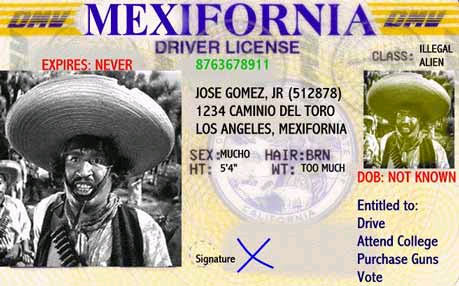
“Mexifornia Driver Licence,” http://lighthousepatriotjournal.wordpress.com/2006/06/27/california-responds-to-forest-fires
The situation differs from state to state. In California, for example, proliferating Spanish-language bill-board are triggering increasing resistance in conservative quarters; and the influential “Save Our State” lobby fights against the ‘invasion’ by foreigners, and extremely xenophobic documents like this driving license42 are being circulated in the Internet:
28It is against this background that by now twenty-seven states have passed ‘English Only’ laws and created a situation which is difficult to define. In California, one can take one’s driving license in almost three dozen languages. In New York, high school leavers can write their GED, or final tests, with the exception of the one in English, in a language of their choice. The Los Angeles administration publishes its ordinances in seven languages. The U.S. Postal Service has issued a brochure meant to help its employees to talk to customers in nine different languages. And in 1992 the INS conducted a citizen swearing-in ceremony almost completely in Spanish. 29Meanwhile, however, there is a growing concern about the role of English as the national language, which in the EFL-classroom can be worked out by starting with Charles Krauthammer’s recent Time essay “In Plain English: Making It Official.”43 The new trend seems to be “to redirect federal subsidies for bilingual education towards programs to help students learn English,”44 and what in 1991 Arthur M. Schlesinger Jr. expressed as a minority opinion now seems ever more widely accepted:[B]ilingualism has not worked out as planned; rather the contrary. Testimony is mixed, but indications are that bilingual education retards rather than expedites the movement of Hispanic children into the English-speaking world and that it promotes segregation more than it does integration. It nourishes self-ghettoization, and ghettoization nourishes racial antagonism. […] Using some language other than English dooms people to second-class citizenship in American society. […] The bilingual campaign has created both an educational establishment with a vested interest in extending the bilingual empire and a political lobby with a vested interest in retaining a Hispanic constituency. […] bilingualism is an elitist, not a popular, movement […] institutional bilingualism remains another source of the fragmentation of America, another threat to the dream of “one people.”45
The bilingualism issue has always been mainly an English-Spanish problem, but today a large majority of Hispanic parents want their children to learn English as fast as possible. In his moving autobiographical book Hunger of Memory (1982), the Chicano intellectual Richard Rodriguez delivers a brilliant plea for learning English as a prerequisite for cultural integration; and in his bestseller The Americano Dream: How Latinos Can Achieve Success in Business and in Life (1998), the successful Latino entrepreneur Lionel Sosa defines the mastery of English as the necessary requirement for economic success:
[…] it is essential for Latinos dealing with Anglo businesses to speak the same language. By this I don’t mean just being fluent in the language of business—English. I mean understanding those subtleties that are part of any communication, things that are implied or left unsaid, a kind of code that can be learned only by acute observation and practice.46
30The present tendency away from bilingualism is somehow related to the gradual abolition of affirmative action, a tendency which is alternately welcomed as a way towards equal treatment and denounced as a form of re-segregation. In California, in 1996 voters passed Proposition 209, which stipulates that “the state shall not discriminate against, or grant preferential treatment to, any individual or group on the basis of race, sex, color, ethnicity, or national origin in the operation of public employment, public education, or public contracting.”47 This led to the abolition of special programs for underprivileged children, of quotas for women and ethnic minorities in university admission, and of a percentage of public contracts for minority businesses. In Texas, where a court ruled “that race cannot be used as a factor in admissions,”48 the situation is similar. It is not clear yet whether an altered form of affirmative action will carry the day or whether other states will follow California and Texas, and it remains to be seen whether the U.S. educational system will manage to integrate the growing number of immigrants from different cultures or whether the country will experience further social fragmentation. 31While the language issue is best taught by means of relevant expository texts, there are also appropriate fictional explorations. The moving little vignette “No Speak English” from Sandra Cisneros’ The House on Mango Street (1991) about a Mexican who, after years of toil, has finally enough money to bring his wife and their little baby to Chicago, where she stays in her room because she speaks no English, is an excellent comment on the high price of linguistic dislocation.49 Another suitable EFL-text is Nicolasa Mohr’s short story “The English Lesson” (1977) about two Puerto Ricans trying to learn English in New York.50 And the funniest treatment is Leo Rosten’s The Education of H*Y*M*A*N K*A*P*L*A*N (1937), a series of stories about a Yiddish-speaking immigrant who goes to night school to learn English and makes such hilarious mistakes as conjugating ‘to die’ as “die, dead, funeral,” explaining that he suffers from “sleepings of the tong,” and declaring that his wife has “high blood pleasure.”51 Since sharing a language and its cultural referents seems to me to be an indispensable prerequisite for national identity, and since the American situation anticipates what we are facing in a Germany with growing Parallelgesellschaften, the aspects of both the official language and some basic cultural knowledge should be a must in any EFL-course. The latter can be profitably taught with the set of flash cards provided by the U.S. Immigration Service.52 And an appropriate introduction to the language question is provided by the recent success of a Spanish-language version of the national anthem as discussed above. 32The two sequences suggested, that is, a historical survey by means of ‘classic’ texts and a unit on the controversy about the language issue, are highly appropriate topics for the advanced EFL-classroom since they can shed light on the crucial issue of national identity in a globalized world and have an immediate transfer value for German students.Notes
1 Both the original text and the Spanish version of “nuestro himno” are available in Peter Freese, ed., Viewfinder Special – Teacher’s Book (München: Langenscheidt, 2008), 377– 79, and audio clips of parts of both versions can be found on the accompanying Audio CDs, CD 2, Nos. 25 and 26. Under the search word <Francis Scott Key> the Internet offers portraits, historical paintings, and a facsimile of the original manuscript, which can be used as additional teaching tools.2 See, e.g., the article “Bush says anthem shouldn’t be sung in Spanish” in the Seattle Times, 29 April 2006 http://seattletimes.nwsource.com/html/ nationworld/2002960428_anthem29.html, and many other newspaper articles which are easily available on the Internet when one uses the search word <nuestro himno + Bush>.3 See the website http://www.stroebele-online.de/suchen/129925.html?searchshow=deutschlandlied, from which the Turkish version can be downloaded as an audio file.
4 Erik H. Erikson, Childhood and Society (Harmondsworth: Penguin Books, 1965), 274.
5 “Friede, Freude, Eierkuchen,” Der Spiegel, 40 (2 October 2006): 49.
6 See Samuel P. Huntington, Who Are We? America’s Great Debate (New York: Simon and Schuster, 2004). This book is also available in both an American and a British paperback edition.
7 Philip Gleason, “American Identity and Americanization,” in Stephan Thernstrom, ed., Harvard Encyclopedia of American Ethnic Groups (Cambridge, Mass., and London: The Belknap Press of Harvard University Press, 1980), 31.
8 Quoted in Forrest Church, “The American Creed,” The Nation, 16 September 2002; here quoted from http://www.thenation.com/doc/20020916/church.
9 As quoted in the entry on “William Tyler Page” in http://en.wikipedia.org/wiki/William_Tyler_Page.
10 Further relevant cartoons are reprinted and analyzed in Peter Freese, “Between Assimilation and Nativism: Popular Expressions of the Changing Concepts of American Identity,” in Negotiations of America’s National Identity, ed. by Roland Hagenbüchle and Josef Raab in cooperation with Marietta Messmer (Tübingen: Stauffenburg, 1999), vol. II, 248–71. This essay is also available in Peter Freese, Teaching ‘America’: Selected Essays (München: Langenscheidt-Longman, 2002), 51–77.
11 The text of this essay, which Kallen would later extend into his more comprehensive study Cultural Pluralism and the American Idea (1956), is available on the informative website http://home.apu.edu/~rgeib/edu-526/melting-pot-v-salad-bowl/
12 Philip Gleason, “American Identity and Americanization,” 46.
13 Quoted in Forrest Church, “The American Creed.”
14 Martin Luther King, “I Have a Dream,” in Peter Freese, ed. The American Dream: Humankind’s Second Chance? Viewfinder New Edition (München: Langenscheidt, 2005 and ff.), 23, lines 121f.
15 In a speech delivered in 1938 to the Augustana Historical Society, which was published in 1952 in an abridged version in Commentary.
16 Oscar Handlin, The Uprooted: From the Old World to the New (London: Watts and Co., 1953), 3.
17 The relevant literature is legion. Some influential books are Dinesh D’souza, Illiberal Education: The Politics of Race and Sex on Campus (New York: The Free Press, 1991; as paperback, with a new introduction by the author, New York: Vintage Books, 1992); Roger Kimball, Tenured Radicals: How Politics Has Corrupted Our Higher Education (New York: Harper & Row, 1990; as a paperback New York: Harper Collins, rpt. 1991); Arthur M. Schlesinger, Jr., The Disuniting of America: Reflections on a Multicultural Society (New York and London: W. W. Norton, 1992 and ff.); Rick Simonson and Scott Walker, eds. The Graywolf Annual Five: Multi-Cultural Literacy (Saint Paul: The Graywolf Press, 1988) [a decidedly multicultural companion piece to E. D. Hirsch, Jr., Cultural Literacy: What Every American Needs to Know (Boston: Houghton Mifflin, 1987 and ff.; as a paperback, ed. by Pat Mulcahy. New York: Vintage Books, 1988). – For an interesting survey of the fuzzy notion of ‘multiculturalism’ see also “Multiculturalism in Education,” http://www.start-at-zero.com/papers/multiculturalism/, and for its often faddish application to EFL-teaching see Peter Freese, “The Chances and Limits of ‘Intercultural Understanding’ in the Advanced EFL-Classroom,” Literatur in Wissenschaft und Unterricht 33, no. 3 (2000): 247–63; rpt. in Peter Freese, Teaching ‘America’: Selected Essays (München: Langenscheidt-Longman, 2002), 11–30.
18 For details see Peter Freese, “Universality vs. Ethnocentricity, or; the Literary Canon in a Multicultural Society,” Zeitschrift für Anglistik und Amerikanistik 44, no. 2 (1996): 155–70, and the literature referred to.
19 See Janice Radway, “What’s in a Name? Presidential Address to the American Studies Association, 20 November, 1998,” American Quarterly 51, no. 1 (1999): 1–32.
20 Samuel P. Huntington, Who Are We? America’s Great Debate, xvii.
21 See ibid.
22 See, e.g. Jim Sleeper’s review, http://hnn.us/articles/4987.html, or Francis Fukuyama’s comments, http://www.slate.com/id/2101756.
23 All quotations from the reprint in Peter Freese, ed., From Melting Pot to Multiculturalism: E pluribus unum? Viewfinder New Edition (München: Langenscheidt, 2005 and ff.), 13–14.
24 Quoted from Peter Freese, ed., Israel Zangwill, “The Melting Pot” (München: Langenscheidt, 2nd ed., 2006), 29.
25 This text is available in Peter Freese, From Melting Pot to Multiculturalism: E pluribus unum? – Resource Book (München: Langenscheidt, 2005), 88.
26 The relevant passage from Middlesex is available in Peter Freese, From Melting Pot to Multiculturalism: E pluribus unum? – Resource Book (München: Langenscheidt, 2005), 89.
27 See Arthur M. Schlesinger, Sr., “America’s Influence: Out Ten Contributions to Civilization,” Atlantic Monthly 203 (March 1959): 67.
28 Nathan Glazer and Daniel Patrick Moynihan, Beyond the Melting Pot: The Negroes, Puerto Ricans, Jews, Italians, and Irish of New York (Cambridge, Mass.: MIT Press, 1963).
29 Rpt. in Peter Freese, ed., The American Dream: Humankind’s Second Chance? 41.
30 Rpt. in Peter Freese, ed., From Melting Pot to Multiculturalism: E pluribus unum? 26–27.
31 Rpt. in Peter Freese, ed., The American Dream: Humankind’s Second Chance? 44–45.
32 The widespread myth, cultivated by such national-socialist propagandists as Colin Ross, that German had almost become the official language of the United States, is not true. Karl J. R. Arndt, “German as the Official Language of the United States of America,” Monatshefte für deutschen Unterricht, deutsche Sprache und Literatur 68, no. 2 (Summer 1976): 129–50, shows that this myth goes back to two events. (1) Seven years after the passing of the Constitution, German-American citizens from Virginia petitioned the Third Congress that all federal laws should be printed in 3,000 copies in German and English, but the House of Representatives rejected this request with a small majority. (2) There are vague reports that in the legislative assembly of Pennsylvania a petition for making German the official language narrowly failed.
33 See Richard L. Worsnop, “Bilingual Education,” The CQ Researcher 3, no. 30 (13 August 1993): 705.
34 Welcome to the United States: A Guide for New Immigrants (Washington: U.S. Citizenship and Immigration Services, no date), available from http://bookstore.gpo.gov.
35 See Abigail M. Thernstrom, “Language: Issues and Legislation,” in Harvard Encyclopedia of American Ethnic Groups, 619–29.
36 The contemporary situation is discussed in detail by Berndt Ostendorf, “Einwanderungsland USA: Zwischen NAFTA und Terrorismus,” Rat für Migration: Politische Essays zu Migration und Integration, 1 (2007), PDF/Ostendorf-Einwanderungsland-USA.pdf.
37 See http://www.us-english.org/.
38 See http://ourworld.compuserve.com/homepages/ JWCrawford/engplus.htm.
39 The complete texts of the two laws are available under http://www.cbo.gov/ftpdocs/72xx/doc7208/s2611.pdf and under http://www.govtrack.us/congress/bill.xpd?bill=h109-4437.
40 Material about the demonstrations on 1 May 2006, known as El Gran Paro Estadounidense, the Great American Boycott, or the Day Without Immigrants, can be found under http://en.wikipedia.org/wiki/Great_American_Boycott.
41 See the title story “Who Gets to Be an American?” and the polls in Time, 10 April 2006.
42 See under http://lighthousepatriotjournal.files.wordpress.com/ 2006/06/mexifornia-license.jpg.
43 See Charles Krauthammer, “In Plain English: Making It Official. Having a unifying language is a secret of America’s success. Why mess with it?” Time International, 12 June 2006, 74.
44 English Language Advocates, http://www.elausa.org/main/programs.htm. —John Micklethwait, “Oh, say, can you see?” The Economist, 11 March 2000, p. 13, points to the Californian Proposition 227, “[which] replaced bilingual education, which around half the students with poor English were receiving, with crash courses in English. Bilingual education, originally invented as a way to steer funds to poor people in the southwest, has always produced disappointing results. It is now merely a sop to the teachers’ unions. Since bilingual education was banned in California about a year ago, test scores have risen. Even more tellingly, the students who were put on the English crash course or into mainstream classes are well ahead of those still stuck in bilingual ones.”
45 Arthur Schlesinger, Jr., The Disuniting of America: Reflections on a Multicultural Society, 109 and 108ff.
46 Lionel Sosa, The Americano Dream: How Latinos Can Achieve Success in Business and in Life (New York: Plume Books, 1999), 105.
47 “Proposition 209: Text of Proposed Law,” http://Vote96.ss.ca.gov/Vote96/html/BP/209text.htm.
48 See Sue Anne Presley, “Texas Campus Attracts Fewer Minorities,” Washington Post, 28 August 1997, A01; also under http://www.washingtonpost.com/wp-srv/politics/special/affirm/stories/aa082897.htm.
49 Cisneros’ text and excerpts from Rodriguez’ and Sosa’s books can be found in Peter Freese, ed., From Melting Pot to Multiculturalism. —An audio version of Cisneros’ texts as read by herself is available in the CDs accompanying Peter Freese, ed., Viewfinder Special, CD2, No. 34.
50 An annotated edition of Mohr’s story is available in Peter Freese, ed., New York Stories (München: Langenscheidt, 1998 and ff.), 103–22.
51 The Education of H*Y*M*A*N K*A*P*L*A*N was so successful that Rosten soon followed it with a sequel, The Return of H*Y*M*A*N K*A*P*L*A*N.
52 The set of Civics Flash Cards (Washington: U.S. Citizenship and Immigration Services, no date) is available from http://bookstore.gpo.gov.
Author
E-mail: peter.freese@upb.de
Suggested Citation

This work is licensed under a Creative Commons Attribution-ShareAlike 3.0 Unported License.


